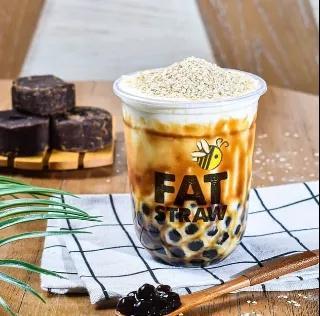Unless you’ve been living under a rock, it’s hard not to notice Taiwan’s long-standing cultural food phenomenon that is bubble tea. Also known as boba, this drink has taken the world by storm, with bubble tea chains springing up like mushrooms around the world from Japan and Malaysia to the United States and Australia.
It’s inspiring to see how this tea preparation has become a full-blown sensation in its land of origin as well as abroad. But who on earth came up with the idea of putting chewy tapioca balls in tea?
As tea drinking is a robust practice in East Asia, milk tea was already a popular drink of choice in Taiwan. Bubble tea is said to have originated in the eighties in the city of Taichung. Several tea companies claim to be the creator, so it’s unclear which is the true founder of the popular drink, but Liu Hanchie of Chun Shui Tang Teahouse in Taichung claims that in the early eighties, he experimented with cold milk tea by adding fruit, syrup, candied yams and tapioca bubbles.
A decade later, the addictively tasty drink reached most parts of East and Southeast Asia with bubble tea shops popping up in every mall and street corner. Since then, it has spread across the globe, including the US, Australia, Europe and South Africa.

What is bubble tea?
A drink of many names, bubble tea is also fondly known as boba tea or black pearl tea. Bubble tea reputedly gained its name as the drink forms bubbles when it is shaken up. Another theory is that the drink was named after the marble-sized tapioca balls resembling bubbles at the bottom of the drink. The tea became known as boba tea because “boba” is slang for “breasts” in Chinese (a reference to the spherical shape of tapioca balls).
Served with an oversized straw, this sweet and refreshing iced drink can be made with any tea. The only prerequisite is that the bottom half of the cup is packed with jellylike pearls, or bubbles. Most shops sell a green or black tea with milk and sweetener added; those who aren’t keen on tea can opt for coffee while the lactose-intolerant can try a milk-free variant.

The perfect cup of bubble tea is determined by the texture of its tapioca balls. They cannot be too squishy, or all of them will stick together in the cup; too hard and they’ll be impossible to chew. Boba lives and dies by the texture of the tapioca balls. There's even a word for that perfect consistency in Chinese – “QQ” – which means “chewy”.
Starting in the nineties, this addictive drink became a huge craze around the world, especially Southeast Asia, presumably because of the growing popularity of cafe culture thanks to Starbucks’ rapid expansion in Asia.

The trend cooled down a little in the early years of the next decade, but then experienced a resurgence when Chatime, Koi, Tiger Sugar, The Alley and Xin Fu Tang opened up in cities across Asia, offering high-quality teas, real milk, and a comfortable, casual atmosphere. Bubble tea lovers were ready to do anything for their favourite drink – even queue for more than 30 minutes for a cup of tea. National Bubble Tea Day was made official last year in Taiwan on April 30. This year in Singapore, Gong Cha celebrated National Bubble Tea Day by teaming up with Deliveroo to hold the country’s biggest bubble tea giveaway.
It’s not clear why this drink obsession took root while so many other drink fads have faded into obscurity. Sure, it’s a staple of the many night markets in Taiwan, where everyone is carrying some variation of bubble tea, whether it’s a fruit drink or milk tea. Perhaps it’s an ideal drink-snack combination for on-the-go Asians to sip on, or maybe it’s the thousand reinventions of the original drink that keep people hooked. Maybe it’s the perfect combination of the chewy, addictive texture of the tapioca balls and the creaminess of the milky tea that people can’t get enough of.
As it grew more widespread locally in Taiwan and abroad over time, bubble tea began to evolve. Fruit bubble tea using fruit powders and syrups in lieu of actual fruit was introduced; this changed later as the demand for fresh ingredients rose. The modern-day bubble tea is generally made in two forms: a fruity, iced tea, consisting of fresh fruit, tea and ice, or a smooth milkshake-like tea, made by combining tea, (sometimes) milk, powdered or liquid flavouring, creamer, water and ice.
The topping choices have also expanded beyond tapioca balls to include aloe, sago, grass jelly, almond jelly, egg custard, konjac and red beans. Even in classic bubble tea, the milk in the milk tea made way for the more shelf-stable non-dairy creamer and as a result, the drink became known for its sweet, creamy taste.

Meanwhile, the chewy tapioca balls that typically come in a black colour (which result from the addition of brown sugar and caramel in the ingredient mix) can also be found in white, transparent or other colours, depending on the ingredients they’re made with.
In recent years, new varieties of bubble tea have captured the world’s attention and taste buds. Last year, cheese tea – cold tea topped with whipped cream cheese – became a global phenomenon, while this year’s craze is based on brown sugar pearl milk, a syrupy treat comprising fresh cold milk, brown sugar caramel and tapioca pearls. In Singapore, you can find variants with a local twist like salted egg custard and avocado, while in Japan, it’s not uncommon to see youngsters sipping on hojicha latte bubble tea.
While its origins may be a little murky, one thing’s for certain: the bubble tea trend is here to stay as shop owners continue to invent new audacious flavours to excite the crowd. It also helps that the drink is highly addictive; if you’ve tried one, you’ll know what I mean.





















